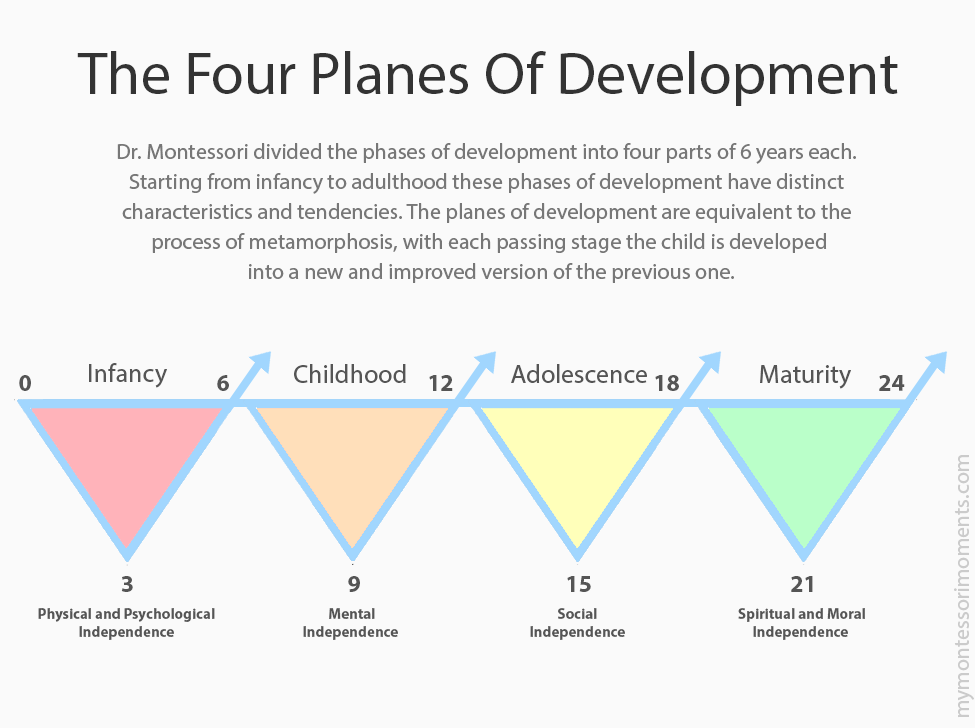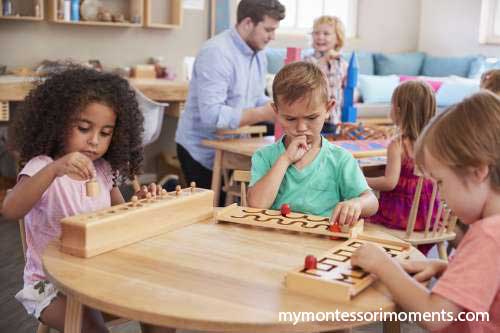The four Planes of Development in Montessori Method
Key Takeaways
- The Planes of Development according to Dr. Maria Montessori, are divided into four parts of 6 years each.
- The Four Planes of Development begins at birth, and ends when the individual reaches adulthood, where they develop distinct characteristics and tendencies.
- Each plane has its own set of needs and requirements that must be met with the help of age-appropriate materials and curriculum.
- The changes or challenges of each plane of development should be identified, to develop a proper system that will counterbalance the adversities and provide effective solutions to the issues.
In the year 1938, Dr. Maria Montessori equipped with the intense observation of human behavior gave a speech on the Philosophy of “Four Planes of Development” that took every aspect of child development into account.
The Philosophy included appropriate aspects of Physical, Psychological, Emotional, and Social principles that facilitate holistic development in children.
Dr. Montessori also observed that children exhibit distinct periods of behavioral change and noticeable psychological, physical as well as intellectual changes.
In her book “Human Tendencies” (1957) which she wrote along with her son Mario Montessori, she mentioned specific elements of human psychology which help the child reach their optimum potential.
These specific tendencies or elements of human behavior are – Movement, Abstraction, Curiosity, Exploration, Orientation, Repetition, Order, Independence, Self-Control, Concentration, Exactness, Imitation, Manipulation, Perfection, Calculation, Work, and Creative Imagination.
According to Dr. Montessori, these tendencies take place at different stages of development. It is essential to understand these tendencies to provide the child with an appropriate environment for different stages.
The planes of development were divided into four parts. According to Montessori, the phases of development are like a “rhythm” of six years and each year has an opening and closing phase. Dr. Montessori called the four planes of development “constructive rhythm of life” these planes of development include four stages of life-
- Infancy
- Childhood
- Adolescence
- Maturity
These planes extend from birth to 6 years, from 6 to 12 years, from 12 to 18 years, and from 18 to 24 years.
The first phase(infancy) starts with a particular set of tendencies and from the second phase, the child acquires new skill sets as well achievements.
Each plane has different characteristics and learning abilities. The understanding and recognition of these four planes of development and human tendencies can help parents and teachers to teach their children with suitable methods.

Contents
Periods of Sensitivity
The four planes of development or the constructive rhythms of life are based on sensitive periods. According to Dr. Maria Montessori, the child has an absorbent mind during the initial six years.
These sensitive periods are heightened periods of interest and focus that occur during the first six years of a child’s life. The child develops a natural curiosity to explore new objects and possibilities.
The periods of sensitivity are ideal to facilitate proper education and instill practical values. The periods of sensitivity include-
- Sensitivity to order
- Sensitivity to language
- Sensitivity to walking
- Sensitivity to the social environment
- Sensitivity to learning through senses
- Sensitivity to small objects.
In the Montessori pedagogy, proximal and holistic development is attained when the periods of sensitivity are aligned with the four planes f development.
The four planes of development:
Dr. Montessori divided the phases of development into four parts of 6 years each. Starting from infancy to adulthood these phases of development have distinct characteristics and tendencies.
The planes of development are equivalent to the process of metamorphosis, with each passing stage the child is developed into a new and improved version of the previous one.
These four planes are marked by Maria Montessori as:
- Infancy (birth to 6 years)
- Childhood (6 to 12 years)
- Adolescence (12 to 18 years)
- Adulthood (18 to 24 years).
The planes are distinct in characteristics but are also parallel. During the first six years and the Adolescence phase, the child is considered to be most creative and turbulent. The adulthood phase and the childhood phase are the “calm phase of growth”.
Regardless of the distinct characteristics, each plane depends on the previous one. The child has different needs and requirements during each plane of development. It is important to recognize the needs of each plane of development.
The First Plane of Development: Infancy
The first plane of development starts from birth to age 6. This plane is further divided into two subdivisions- birth to 3 years and 3 to 6 years.
In the First Stage of infancy (birth to 3 years) the child is described as a “spiritual embryo” by Dr. Maria Montessori. Infants during the first stage acquire information solely on the basis of their senses.
This phase is self-directed and the child is mentioned as an “unconscious creator” by Dr. Montessori during this plane. The child is unaware of the surroundings yet, starts developing a foundation to become the person he/she has to turn into. The Montessori method lets the child develop motor and speaking skills independently.
From age 3 child starts expanding their horizons and developing consciousness. The child has an absorbent mind at this stage.
The child becomes aware of the surroundings and oneself, it is a new beginning for the child as a “conscious worker”.
The child can interact with the surrounding environment and maneuver the objects deliberately. The child develops self-control and self-awareness.
The child at this stage is joyful, curious, hardworking, easily entertained, and starts to concentrate. When given the chance to develop independently and freely we see the child’s inner potentialities, as well as personality, come out. This is described as ‘normalization’.
Ages 3 to 6 are the period of crystallization in the first plane of development. The child is able to develop self-confidence, self-awareness, and self-control. The second sub-plane is referred to as ‘the embryonic period for the formation of character’ by Dr. Montessori.
In the first plane of development, the leads on a journey of self-exploration, and traits like confidence, concentration, as well as independence are easily identifiable. During this stage, the child combines physical and mental capabilities to acquire development from within.
The Second Plane of Development: Childhood
The second phase of development is referred to as the “calm phase of growth”. It starts from age 6 to 12 years.
This plane of development is considered to be calm and stable. This phase is also called the period of intellectual growth as the child is able to open up and explore new opportunities to broaden their horizons.
The Montessori method during this stage promotes a curriculum that facilitates cognitive development. The child has an opportunity to learn about cultures, morals, society, and the open environment.
The child understands social queues and is able to build functioning social groups with peers. The Montessori curriculum caters to the child’s natural curiosity. The child develops a new interest in nature, and mankind, and is capable of drawing complex conclusions.

Montessori wanted children between the ages of 6 to 12 to acquire knowledge of culture. This knowledge included complex topics relating to mankind and the universe.
Dr. Montessori’s plan to facilitate education to children during the second phase includes- history, language, culture, music, science, mathematics, and knowledge of the universe and its functioning. Montessori referred to this curriculum as “cosmic education“.
It is important to develop social and ethical values in children during the second phase of development.
The child has an intense interest in law, justice, and fairness. The social, moral, and intellectual knowledge during the second phase helps the child become a responsible, thoughtful, intellectual, and self-aware individual.
The Third Plane of Development: Adolescence
This plane of development is considered to be the phase of “rebirth” as the child embarks on the journey to becoming an adult. Followed by the calm, stable period of intellectuality of the Second plane, the third plane of development is a period of instability.
This plane of development starts from the age of 12 to 18 years. During the third phase, the child not only transitions mentally but also physiologically. This phase is also called Puberty or Adolescence.
The physical changes in the third plane occur rapidly and dramatically, leading to intense emotional outbursts.
Along with physical changes, children also have significant growth of the pre-frontal lobe of their brain which controls functioning, reasoning, planning, memory, and mood.
The Montessori method facilitates the education of both social and economical aspects of adulthood.
The teenager is able to participate in a real-life situation with real-life consequences that prepare them for the future. This method was described by Montessori as “valorization” meaning the internal and external validation of inner potentialities and personality.
The Montessori method also focuses on the physical growth of teenagers along with the development of social, emotional, cultural, and practical growth.
With all aspects of development covered and explored the child is then returned back to the traditional educational setting for the intellectual preparation of the fourth plane.
The Fourth Plane of Development: Maturity
The Fourth plane of development starts from the age of 18 to 24 years. It is the phase of spiritual strengthening and independence. The individual becomes a fully functioning adult with personal aspirations, a sense of responsibility, and a high level of moral consciousness.
The third plane prepares the individual to venture out into the world and find their footing. The individual becomes a contributing part of society and aspires to lead a respectable life.
Unlike the widely accepted and known first two planes of development and some sources about the third plane, there is not much written about the fourth plane of development. The fourth plane of development is based on the decisions and changes the individual might make.
The individual is capable of understanding, processing, and executing abstract, complex as well as practical ideas.
What is the Significance of the Four Planes of Development?
While to most individuals the thorough discussion on different stages of child development may seem impractical, the intimate knowledge of the Four Planes of Development in Montessori is the pillar of the Montessori Method of education.
It is important to note that your child is on a journey to become a contributing adult, and through the voyage, they face several ups and downs that have to accept.
Once these changes or challenges are successfully identified, a proper system can be developed to counterbalance such adversities and provide effective solutions to the issues.
The Four Planes of Development in Montessori are the pillars of Montessori Philosophy and Montessori Principles.
The Four Planes of development contribute to the development of an effective Montessori Curriculum, Montessori Materials, Montessori Environment, and Montessori Activities.
Essentially, the Four Planes of Development in Montessori provides the child with age-appropriate materials, apparatus, and curriculum for the child to thrive.
See Also: